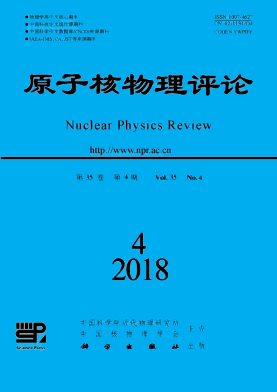|
[1]
|
MAYER M G. Phys Rev, 1949, 75:1969. |
|
[2]
|
TANIHATA I, HAMAGAKI H, HASHIMOTO O, et al. Phys Rev Lett, 1985, 55:2676. |
|
[3]
|
HANSEN P G, JONSON B. Euro Phys Lett, 1987, 4:409. |
|
[4]
|
NEYENS G. Phys Rev C, 2011, 84:064310. |
|
[5]
|
NEYENS G. J Phys G:Nucl Part Phys, 2016, 43:024007. |
|
[6]
|
GAUDEFROY L, DAUGAS J M, HASS M, et al. Phys Rev Lett, 2009, 102:092501. |
|
[7]
|
STEPPENBECK D, TAKEUCHI S, AOI N, et al. Nature, 2013, 502:207. |
|
[8]
|
WIENHOLTZ F, BECK D, BLAUM K, et al. Nature, 2013, 498:346. |
|
[9]
|
OTSUKA T, SUZUKI T, FUJIMOTO R, et al. Phys Rev Lett, 2005, 95:232502. |
|
[10]
|
YANG X F(COLLAPS and CRIS collaboration). J Phys:Conference Series, 2018, 1024:012031. |
|
[11]
|
NEUGART R. Nucl Instr Meth Phys Res, 1981, 186:165. |
|
[12]
|
MUELLER A C, BUCHINGER F, KLEMPT W, et al. Nucl Phys A, 1983, 403:234. |
|
[13]
|
VINGERHOETS P, FLANAGAN K T, AVGOULEA M, et al. Phys Rev C, 2010, 82:064311. |
|
[14]
|
LU Z T, MUELLER P, DRAKE G W F, et al. Rev Mod Phys, 2013, 85:1383. |
|
[15]
|
GARCIA RUIZ R F, BISSELL M L, BLAUM K, et al. Nat Phys, 2016, 12:162501. |
|
[16]
|
FLANAGAN K T, VINGERHOETS P, AVGOULEA M, et al. Phys Rev Lett, 2009, 103:142501. |
|
[17]
|
FERRER R, BARZAKH A, BASTIN B, et al. Nat Commun, 2017, 8:14520. |
|
[18]
|
LAATIAOUI M, LAUTH W, BÄCKE H, et al. Nature, 2016, 538:495. |
|
[19]
|
RAEDER S, ACKERMANN D, BÄCKE H, et al. Phys Rev Lett, 2018, 120:232503. |
|
[20]
|
MANE E, BILLOWES J, BLAUM K, et al. The Eur Phys J A, 2009, 42:503. |
|
[21]
|
LYNCH K M, RAJABALI M M, AGHAEI-KHOZANI H, et al. J Phys:Conference Series, 2012, 381:012128. |
|
[22]
|
CAMPBELL P, MOORE I D, PEARSON M R, et al. Prog Part Nucl Phys, 2016, 85:127. |
|
[23]
|
MUELLER P, SULAI I A, VILLARI A C C, et al. Phys Rev Lett, 2007, 99:252501. |
|
[24]
|
WANG L B, MUELLER P, BAILEY B, et al. Phys Rev Lett, 2004, 93:142501. |
|
[25]
|
MUELLER P, WANG L B, DRAKE G W F, et al. Phys Rev Lett, 2005, 94:133001. |
|
[26]
|
MULLER P, WANG L B, BAILEY K, et al. Nucl Instrum Methods Phys Res Sec B, 2003, 204:536. |
|
[27]
|
SANCHEZ R, NORTERSHAUSER W, EWALD G, et al. Phys Rev Lett, 2006, 96:033002. |
|
[28]
|
NORTERSHAUSER W, TIEDEMANN D, ZAKOVA M, et al. Phys Rev Lett, 2009, 102:062503. |
|
[29]
|
GEITHNER W, NEFF T, AUDI G, et al. Phys Rev Lett, 2008, 101:252502. |
|
[30]
|
HUBER G, TOUCHARD F, BUTTGENBACH S, et al. Phys Rev C, 1978, 18:2342. |
|
[31]
|
POVES A, RETAMOSA J. Phys Lett B, 1987, 184:311. |
|
[32]
|
OTSUKA T, SUZUKI T, HONMA M, et al. Phys Rev Lett, 2010, 104:012501. |
|
[33]
|
KOWALSKA M, YORDANOV D T, BLAUM K, et al. Phys Rev C, 2008, 77:034307. |
|
[34]
|
NEYENS G, KOWALSKA M, YORDANOV D, et al. Phys Rev Lett, 2005, 94:022501. |
|
[35]
|
XU Z Y, HEYLEN H, ASAHI K, et al. Phys Lett B, 2018, 782:619. |
|
[36]
|
YORDANOV D T, BISSELL M L, BLAUM K, et al. Phys Rev Lett, 2012, 108:042504. |
|
[37]
|
YORDANOV D T, KOWALSKA M, BLAUM K, et al. Phys Rev Lett, 2007, 99:212501. |
|
[38]
|
HOLT J D, OTSUKA T, SCHWENK A, et al. J Phys G:Nucl Part Phys, 2012, 39:085111. |
|
[39]
|
HEBELER K, HOLT J D, MENENDEZ J, et al. Annu Rev Nucl Part Sci, 2015, 65:457. |
|
[40]
|
TARASOV O B, AHN D S, BAZIN D, et al. Phys Rev Lett, 2018, 121:022501. |
|
[41]
|
PAPUGA J, BISSELL M L, KREIM K, et al. Phys Rev Lett, 2013, 110:172503. |
|
[42]
|
PAPUGA J, BISSELL M L, KREIM K, et al. Phys Rev C, 2014, 90:034321. |
|
[43]
|
GARCIA RUIZ R F, BISSELL M L, KREIM K, et al. Phys Rev C, 2015, 91:041304. |
|
[44]
|
KREIM K, BISSELL M L, PAPUGA J, et al. Phys Lett B, 2014, 731:97. |
|
[45]
|
CRAWFORD H L, JANSSENS R V F, MANTICA P F, et al. Phys Rev C, 2010, 82:014311. |
|
[46]
|
KOSTER U, STONE N J, FLANAGAN K T, et al. Phys Rev C, 2011, 84:034320. |
|
[47]
|
CHEAL B, BILLOWES J, BISSELL M L, et al. J Phys:Conference Series, 2012, 381:012071. |
|
[48]
|
YANG X F, TSUNODA Y, BABCOCK C, et al. Phys Rev C, 2018, 97:044324. |
|
[49]
|
SAHIN E, BELLO GARROTE F L, TSUNODA Y, et al. Phys Rev Lett, 2017, 118:242502. |
|
[50]
|
OLIVIER L. FRANCHOO S, NⅡKURA M, et al. Phys Rev Lett, 2017, 119:192501. |
|
[51]
|
HEYDE K, WOOD J L. Rev Mod Phys, 2011, 83:1467. |
|
[52]
|
ANDREYEV A N, HUYSE M, VAN DUPPEN P, et al. Nature, 2000, 405:430. |
|
[53]
|
COCOLIOS T E. Hyperfine Interact, 2017, 238:16. |
|
[54]
|
ULMS G. BHATTACHERJEE K, DABKIEWICZ P, et al. Z Phys A Atomic Nuclei, 1986, 325:247. |
|
[55]
|
YANG X F, WRAITH C, XIE L, et al. Phys Rev Lett, 2016, 116:182502. |
|
[56]
|
WRAITH C, YANG X F, XIE L, et al. Phys Lett B, 2017, 771:385. |
|
[57]
|
NEYENS G. Rep Prog Phys, 2003, 66:633. |






 甘公网安备 62010202000723号
甘公网安备 62010202000723号 DownLoad:
DownLoad: